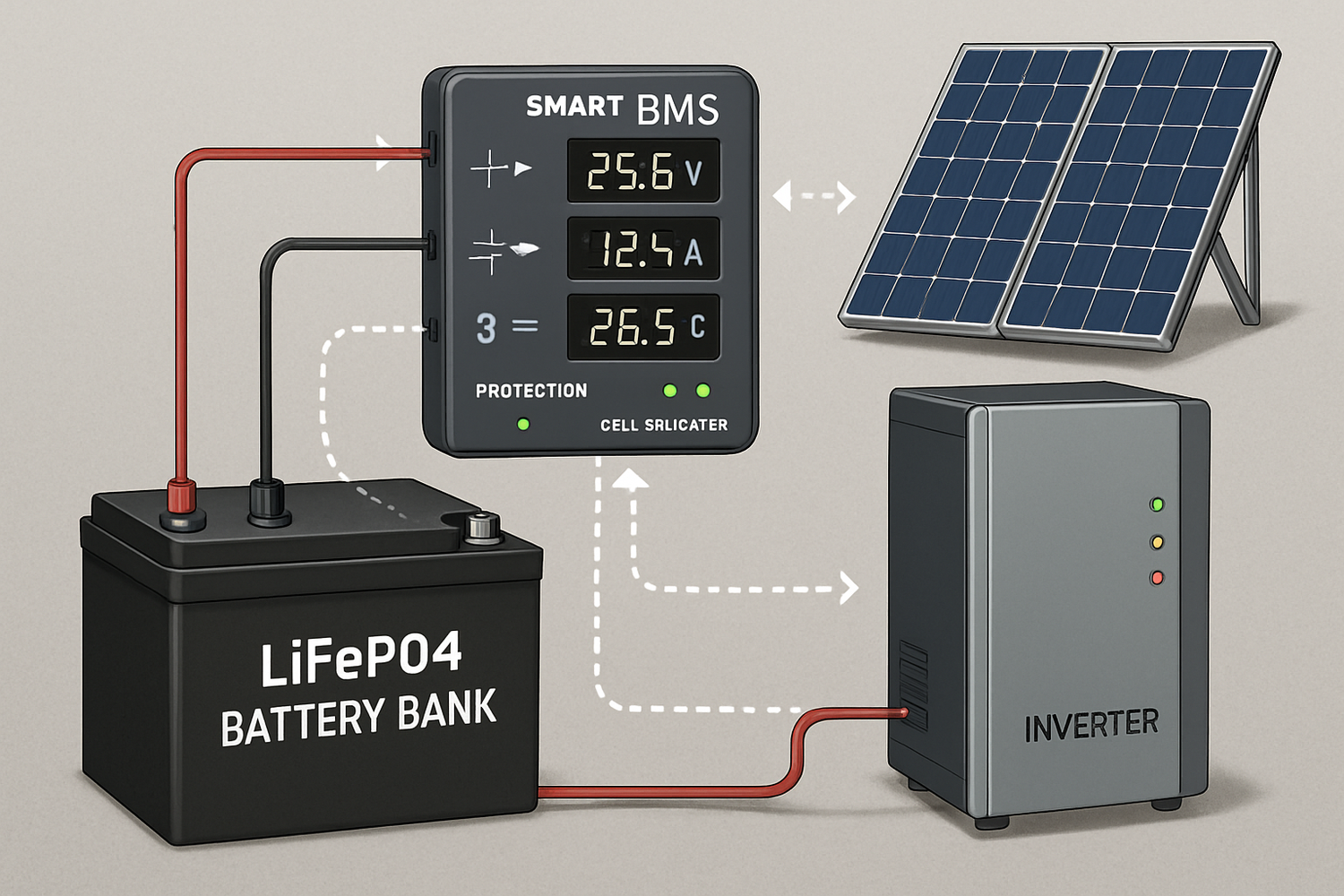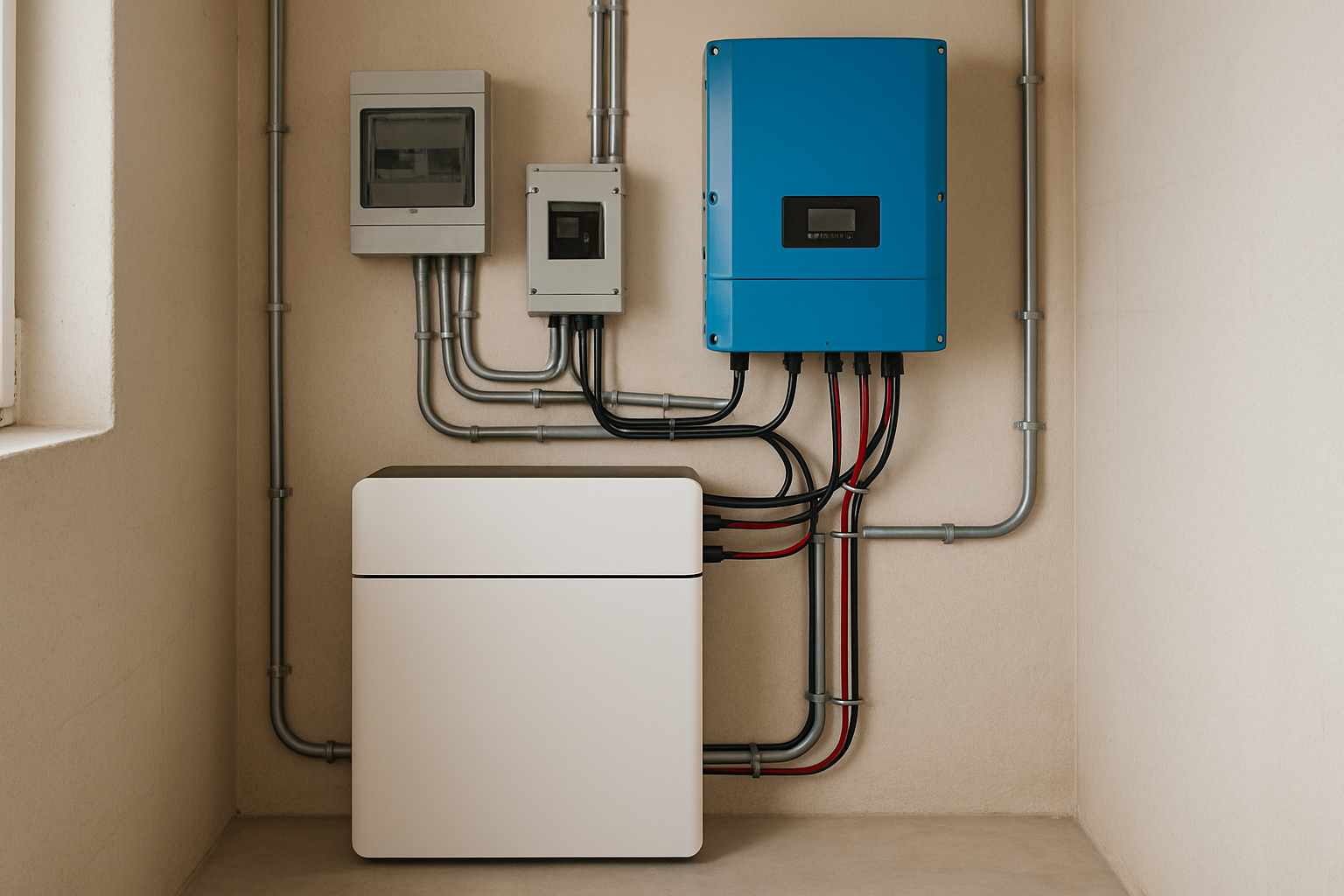For anyone relying on an off-grid power system, the LiFePO4 battery bank is a cornerstone of energy independence. Protecting this investment and ensuring its longevity is paramount. This is where a Smart Battery Management System (BMS) becomes indispensable. A Smart BMS does far more than simple monitoring; it actively safeguards your battery, ensuring optimal performance and extending its operational life.
Our company has extensive experience in the solar and energy storage industry, focusing on LiFePO4 battery manufacturing, energy storage systems, and integrated ESS development. We understand the critical role a well-configured Smart BMS plays in off-grid solutions, from homes to farms and remote cabins.

The Role of a Smart BMS in Off-Grid LiFePO4 Systems
A Smart BMS acts as the brain of your battery system, constantly overseeing its health and operation. It is an integrated electronic system designed to regulate and protect lithium batteries. It monitors critical parameters such as voltage, current, temperature, and state of charge to maintain optimal performance.
Beyond Basic Protection: Active Management
Traditional battery management systems offer fundamental protection, preventing catastrophic failures. A Smart BMS goes further by actively managing the battery's performance. It detects potential problems in real-time and makes necessary adjustments to optimize performance. This proactive approach significantly extends the battery's lifespan and enhances overall system reliability.
Key Functions for LiFePO4 Longevity
A Smart BMS performs several key functions. It ensures balanced cells, provides real-time system protection, and delivers dependable power even in demanding conditions. These functions are crucial for preventing overcharge, deep discharge, overheating, and other factors that can lead to battery degradation or failure.
Essential Smart BMS Settings for Optimal Performance
Configuring your Smart BMS correctly is vital for the safety and efficiency of your off-grid LiFePO4 bank. The specific settings depend on your battery's characteristics and application. It is always best to consult the manufacturer's datasheet and instructions.
Voltage Protection Parameters
Voltage parameters are fundamental for preventing damage. A LiFePO4 Battery BMS tracks the voltage of each cell to prevent overcharging or deep discharging. LiFePO4 cells typically operate between 2.5V and 3.65V. Exceeding these limits risks thermal runaway or cell damage.
- Overvoltage Protection (OVP): This setting cuts off charging when a cell's voltage reaches a high threshold, typically around 3.6 volts per cell. For a 12V battery pack (4 cells in series), this would be around 14.4V-14.6V. Some systems might use 3.35V per cell for 90% SOC.
- Undervoltage Protection (UVP): This halts discharge when a cell's voltage drops too low, usually between 2.5-3.0 volts per cell. This prevents deep discharge, which can reduce battery life and performance. For a 12V pack, this could be around 10.0V.
Current Management
Monitoring and controlling current flow protects against overloading and short circuits. The BMS monitors charging and discharging currents to avoid overloading.
- Charge Overcurrent Protection: This limits the incoming current during charging. It should be set based on the battery's capacity and the charging source. For example, a 100Ah battery with a 0.5C charge rate might have a 50A limit.
- Discharge Overcurrent Protection: This prevents excessive current draw from the battery. It should be set based on the maximum load the battery supports. If your maximum load is 100A, the discharge current should be set to at least 100A. The BMS will disconnect the circuit if the current exceeds this limit.
- Short Circuit Protection (SCP): This instantly cuts off power during a short circuit to prevent damage and safety risks.
Temperature Control
Temperature significantly impacts LiFePO4 battery performance and safety. A Smart BMS uses sensors to monitor battery and ambient temperatures, preventing overheating or freezing.
- Over-Temperature Protection (OTP): This pauses operation if the battery gets too hot. High temperatures accelerate battery aging. For LiFePO4, the safe operating range is typically 0-45°C (32-113°F).
- Under-Temperature Protection (UTP): This limits or prevents charging in cold conditions. Charging a LiFePO4 battery below 0°C can cause irreversible damage. The BMS can prevent charging until the temperature rises to a safe level.
Advanced BMS Features for Enhanced Off-Grid Reliability
Beyond fundamental protections, advanced Smart BMS features offer further optimization and insight into your battery's health.
Cell Balancing Strategies
Individual cells within a battery pack can drift in voltage over time, leading to an imbalance that reduces the pack's overall usable capacity and lifespan. A BMS actively balances cells by managing charge and discharge through passive or active methods. This ensures all cells charge and discharge uniformly, maximizing the pack's efficiency and longevity.
State of Charge (SOC) and State of Health (SOH) Monitoring
These metrics provide crucial insights into your battery's status.
- State of Charge (SOC): This estimates the remaining battery capacity, helping you understand how much power you have left. It is often displayed as a percentage.
- State of Health (SOH): This estimates the battery's overall condition and its ability to deliver specified performance compared to a new battery. SOH helps predict the battery's remaining useful life.
The most recommended working range for SOC is often 10% to 90%, though 5% to 95% is also considered good.
Communication and Data Logging
Modern Smart BMS units offer communication interfaces like Bluetooth, UART, RS485, or CAN, allowing remote monitoring and control via apps or other devices. Data logging features record historical performance, including voltage, current, temperature, and fault events. This data is invaluable for troubleshooting, optimizing system settings, and understanding long-term battery behavior. According to IRENA's Innovation Outlook: Smart Charging for Electric Vehicles, smart charging and advanced management are crucial for integrating renewable energy sources and optimizing energy flow, principles that extend to stationary storage.
Implementing and Monitoring Your Smart BMS Settings
Proper implementation and ongoing monitoring are key to realizing the full benefits of your Smart BMS.
Initial Configuration Best Practices
When setting up your Smart BMS, follow these guidelines:
- Read the Manual: Always refer to your specific BMS and battery manufacturer's documentation for precise settings and procedures.
- System Sizing: Ensure your battery bank and BMS are appropriately sized for your off-grid loads and charging sources.
- Gradual Adjustment: Make small, incremental adjustments to settings and monitor performance closely.
- Test Thoroughly: After configuration, conduct controlled charge and discharge tests to verify that all protection mechanisms function as intended.
Regular Monitoring and Adjustment
A Smart BMS provides real-time data, but regular human oversight is still beneficial. Periodically check your battery's SOC, individual cell voltages, and temperature readings. Adjust settings as needed based on seasonal changes, load variations, or battery aging. The IRENA Electricity Storage Valuation Framework highlights that behind-the-meter storage, like off-grid battery banks, can significantly reduce electricity bills and provide backup power, underscoring the value of well-managed systems.
For example, in regions with high solar generation, optimizing charging to mid-day can be beneficial, a concept similar to how smart charging for EVs can complement solar by shifting charging to mid-day.
Troubleshooting Common BMS Alerts
Understand what different BMS alerts signify. Common alerts include overvoltage, undervoltage, overcurrent, and over-temperature. When an alert occurs, investigate the cause promptly. The BMS can take corrective action, such as shutting down the battery or reducing the charge rate, to prevent a dangerous situation. For instance, if an overcurrent alert triggers, check for short circuits or excessive load demands. If a temperature alert sounds, ensure proper ventilation or address extreme ambient conditions.
Securing Your Off-Grid Energy Future
A properly configured Smart BMS is a critical component for any off-grid LiFePO4 battery system. It safeguards your investment, optimizes performance, and provides peace of mind. By understanding and utilizing the essential and advanced settings, you ensure your battery bank operates safely and efficiently for years. This commitment to robust, reliable energy solutions helps you achieve true energy independence.
Frequently Asked Questions
What is the main purpose of a Smart BMS in an off-grid LiFePO4 system?
The main purpose of a Smart BMS is to protect, monitor, and optimize the performance of your LiFePO4 battery bank in an off-grid system. It prevents overcharging, over-discharging, overcurrent, and extreme temperatures, ensuring the battery operates safely and efficiently.
How do voltage protection settings work in a Smart BMS?
Voltage protection settings, such as Overvoltage Protection (OVP) and Undervoltage Protection (UVP), define the safe operating voltage range for individual battery cells and the entire pack. The BMS disconnects the battery from charging or discharging if voltages exceed or fall below these set thresholds, preventing damage.
Can a Smart BMS help extend the lifespan of my LiFePO4 batteries?
Yes, a Smart BMS significantly extends battery lifespan. By preventing harmful conditions like overcharging, deep discharging, and thermal stress, and by actively balancing cells, the BMS ensures the battery operates within its optimal parameters, maximizing its cycle life and overall health.
Are there specific temperature ranges for LiFePO4 batteries that a BMS manages?
Yes, LiFePO4 batteries operate best within a specific temperature range, typically 0-45°C (32-113°F) for charging and discharging. A Smart BMS monitors battery temperature and will prevent charging or discharging if temperatures fall outside this safe range, especially below freezing, to avoid irreversible damage.
What communication features do Smart BMS units offer for off-grid systems?
Many Smart BMS units offer communication interfaces like Bluetooth, UART, RS485, or CAN. These allow users to monitor battery status, adjust settings, and receive alerts remotely via dedicated apps or system controllers, enhancing convenience and control over the off-grid power system.





Leave a comment
All comments are moderated before being published.
This site is protected by hCaptcha and the hCaptcha Privacy Policy and Terms of Service apply.